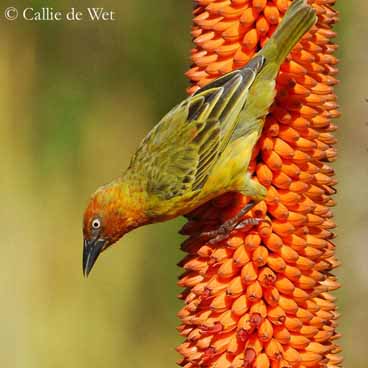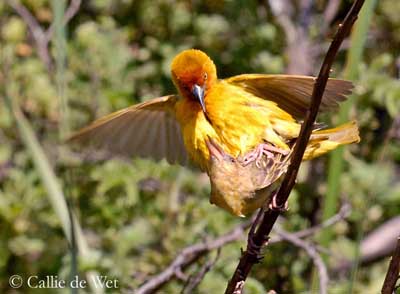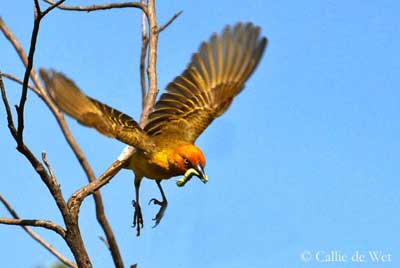
Cape Weaver
Ploceus capensis
Passeriforme Order – Ploceidae Family
BIOMETRICS: Length: 17 cm
DESCRIPTION:
Cape Weaver is a large colonial bird.
Cape Weaver male in breeding plumage has dull yellow-green upperparts with dark bronze markings giving a mottled back. Wings are blackish with yellow-green edges. Tail is dark greenish with yellow-green edges too.


Underparts are yellow on breast and belly.
Head shows a chestnut wash over face, forehead, chin, throat and upper breast. Lores are blackish. Crown and nape are yellow, slightly tinged with green.
Long pointed bill is strong and conical, and black in colour. Eyes are whitish. Legs and feet are pinkish brown.
Non breeding male resembles female, with buff throat and breast.
Female has greyish green upperparts with dull mottled effect on back. Underparts are yellowish-white with more yellow on breast and greener on flanks.
Head is greenish with paler chin and throat. Bill is pale flesh colour. Eyes are brown. Legs and feet are pinkish brown.
Female in breeding plumage is brighter yellow below.
Juvenile is similar to female.
VOICE:
Cape Weaver’s contact call is a “chack” or “azwit-azwit”. Alarm call is a sharp “chip-chip”. Song is a harsh, hysterical sizzling song.

HABITAT:
Cape Weaver lives in grasslands and scrubs. This species breeds in reeds along rivers and dams, or in trees. It is also found in agricultural landscapes rather than natural fynbos. It avoids low areas and dry Karoo regions.
RANGE:
Cape Weaver is a resident species, endemic to South Africa.
BEHAVIOUR:
Cape Weaver feeds mainly on seeds and insects. They may be found in small flocks, foraging some distance from breeding sites. In winter, they glean in trees for insects or other foods, and on the ground. They also visit Aloes for nectar and pollen. Winter flocks are larger than at other time of the year.
Male is polygamous with more than one mate. They nest in large colonies, as in reedbeds or in trees, close to dams and farmlands. They are gregarious birds.

In order to attract females, male builds several nests, and then, it advertises to females. Male weaves the nests and those are used as a display to lure females. Male may hang at the base of the nest, upside down, flapping its wings and swaying from side to side. These displays are accompanied by excited buzzing call.
Within the colony, each male may defend its small territory. Females are attracted by aggressive and dominant males. Male has to attract female to the nest while it is still fresh and green.
Polygynous male will attract other female when the first has laid in one of the nests. When attracted, female enters its nest and pecks it to check its strength.

FLIGHT:
Cape Weaver male may fly a total of about 20 km in order to collect nest materials.
REPRODUCTION:
In some regions of South-western Cape, Cape Weaver starts to breed as early as July, but generally, nesting occurs from August to October in wet areas.
Cape Weaver nests often hang from the dropping branches of Willow-trees. Materials used for the nest include fine leaf-fibbers, grasses and small twigs. Male starts by building a ring with woven grasses, and from this ring, it weaves the brood chamber, and after this first work, it leans backwards in order to prepare the ante-chamber. We can see a downward facing entrance. Nest is suspended from a branch or reed and it is relatively big.
Usually in Weavers, female lays 2 to 4 eggs. Incubation lasts about 11 to 17 days, by female. Young fledge at about 11 to 20 days.
These facts are available for several Weavers. No particular study results for Cape Weaver.


DIET:
Cape Weaver feeds on insects, seeds and parts of flowers, but they also consume pollen and nectar from Aloes.
PROTECTION / THREATS / STATUS:
Cape Weaver is a common species in its range. It is endemic to South Africa. This species has probably increased with expansion of croplands and building of dams.
In the Cape Province, Cape Weaver is unprotected and often destroyed by farmers because they damage cultivated areas.
Fr: Tisserin du Cap
All : Kapweber
Esp : Tejedor de El Cabo
Ital : Tessitore del Capo
Nd : Kaapse Wever
Photographs byCallie de Wet
GALLERY
Text by Nicole Bouglouan
Sources:
BIRDS OF AFRICA SOUTH OF THE SAHARA by Ian Sinclair and Peter Ryan - Princeton University Press Princeton and Oxford - ISBN: 0691118159
Wikipedia (Wikipedia, The Free Encyclopedia)